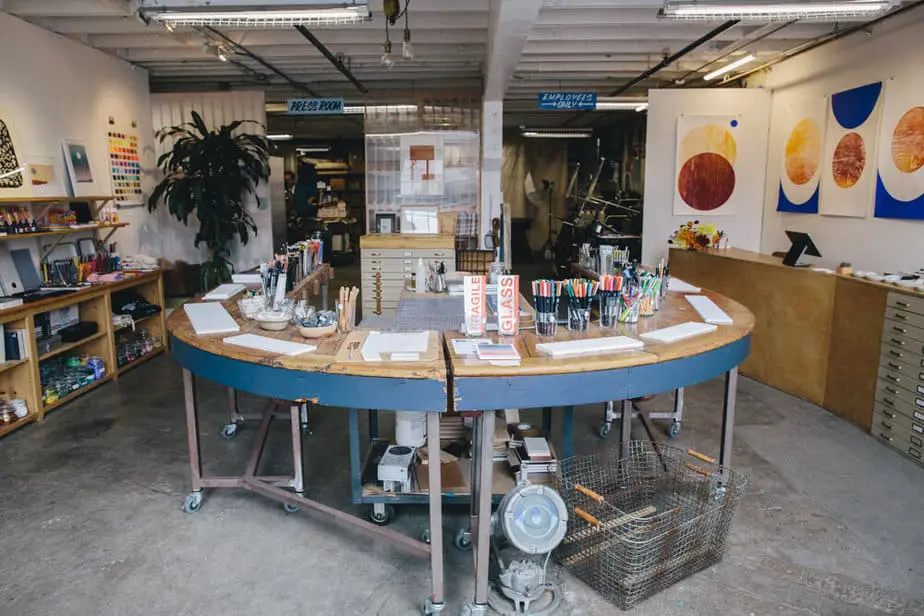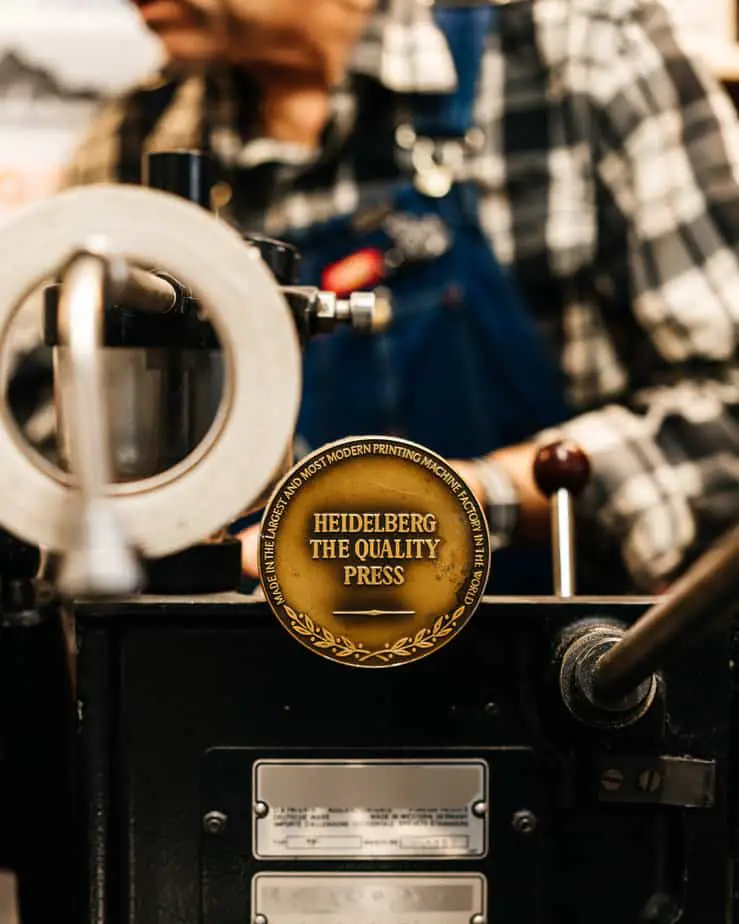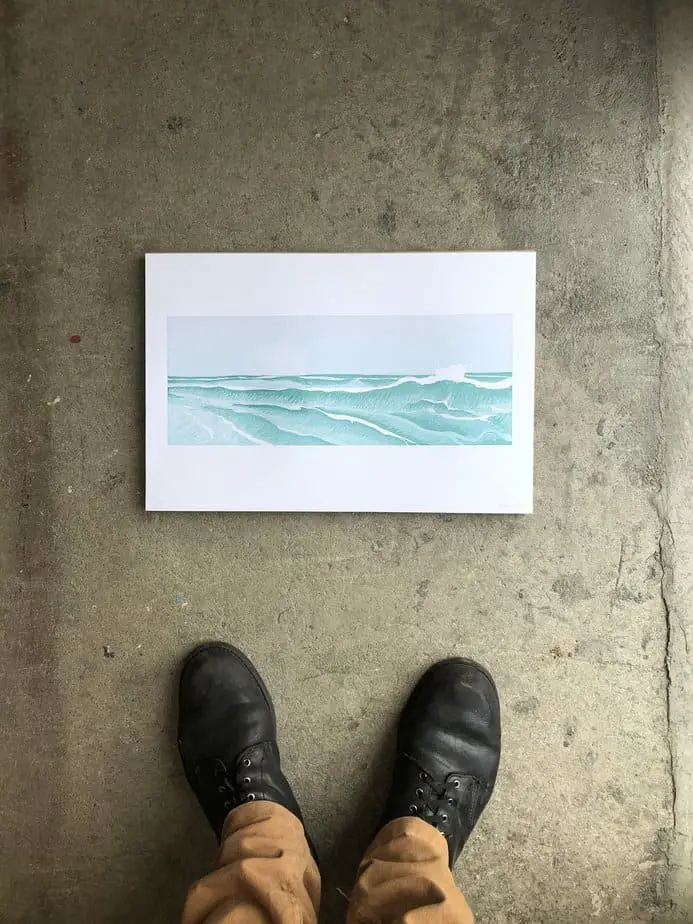James Lewis Tucker was born in 1984 in Red Bank, NJ. As a child he split his time between collecting seashells from the shore and exploring the brooks of his grandparent’s Christmas tree farm. James opened The Aesthetic Union, his letterpress shop and design studio, in 2013 and together with his small team has worked closely with both large and small companies to create traditional printed matter using contemporary techniques.
His art practice is woven into the framework and production schedules of the shop’s presses. He produces limited edition prints that investigate both traditional landscape prints inspired by the California Coast as well as minimalist, experimental mono prints. His work has been shown in major galleries and is housed in permanent collections. James is passionate about keeping the tradition of letterpress alive while also utilizing modern processes which has helped The Aesthetic Union remain a hub for art, craft and design within a shrinking community of creatives in San Francisco.
We got a moment to ask Tucker some questions about his practice, art, and how business collides with it all.
Please give our readers an introduction, if they may not already know you who are.
Hi, I’m James, the owner and founder of The Aesthetic Union. I opened this letterpress and design studio in 2013. We have a small team that works closely with companies- large and small- to create traditional printed matter using contemporary techniques. I weave my art practice into the framework and production schedules of the shop’s presses, and we produce limited edition prints as well as minimalist, experimental mono prints. At The Aesthetic Union, we’re passionate about keeping the tradition of letterpress alive while also utilizing modern processes. This has helped our studio remain a hub for art, craft and design within a shrinking community of creatives in San Francisco.
Tell us the journey in creating a space of creativity and any learning points you’ve acknowledged over the years?
Above all else you have to have a strong vision. You have to make it about everyone, not just yourself. If you make it about yourself, it’s just more ego and we don’t need more ego in the world, especially right now. You have to be open to people influencing that vision, don’t be afraid to let it evolve over time and with circumstance. Doing this encourages an open atmosphere of collaboration that breeds creativity instead of stifling it.
Tell us a bit about the space you’re currently in—how do you utilize it for all aspects of your business?
The space, as it stands, is roughly 1700 square feet of mayhem. Because of the virus, our storefront is shuttered and things are absolutely strewn about. Before COVID-19, the back of the shop was the design & print studio, where we’d make and fulfill custom orders, art prints and hold workshops. The front of the shop is a partnership with Case for Making that offers handmade watercolors and paper goods that are also produced in house. Honestly, it’s hard to operate in a space that was built to be visited in person. So, we’re having to adjust the space and use. Currently, we’re using the full 1700 square feet for printing, contributing to the creative chaos.
As an artist and a business person, when do you feel the most powerful?
I feel the most powerful when I can pay my staff what they deserve, and do the same for myself.
What are some of the challenges in your practice that you’ve come to know, love, or despise?
Precision is the number one challenge. You can do a lot of projects half-assed but you can’t do letterpress half-assed. There’s very few professions that are this intricate. You can notice imperfections in nearly anything, but on letterpress they truly stand out, which is why you have to make it perfect. It’s up there with couture dresses and bespoke suits. The level of precision you have to have is tiring. This is why we exist. I built this business to be a factory that rebels against mediocrity. I push the levels of craft to such a point it begins to look easy, when in fact it’s the farthest thing from. Luckily, I’ve got a really great team who has a good eye for it. If I don’t go home tired at the end of the day, something isn’t right.
A challenge I love is focusing and making art and new projects never before attempted, and having the facility in which I can take on and solve those challenges. I despise the politics of dealing with people. I’m a very straightforward person, and if I see something wrong I’m going to say it and sometimes people don’t like to hear it.
Any artists in the SF Bay Area that you look to for inspiration or to recalibrate your juices?
I would say David Lance Goines, Tom Killion, and Mayumi Oda are my inspirations.
What would you say to an aspiring business artist that wants to get into the field in an SF Bay Area perspective?
Are you sure?! I’m half-kidding. You have to really want it and be aware of the challenges it brings and come armed to take them on. Art as a business in America is extremely challenging, especially in San Francisco, a city that focuses on tech and restaurants as its core. But really, I don’t think of The Aesthetic Union as an art business. We’re manufacturing, employing highly skilled craftspeople. While people consider letterpress an art, it’s much more a craft—meaning it’s more apt to being a business than say, painting, while focuses like sign painting or ceramics are more geared towards business.
Also, think about the practical aspects of what you can offer and the different ways you can generate income. Don’t just focus on one offering. We do more than custom work: we do art prints, we do workshops on top of custom work … if any one of those revenue streams dries up another can take its place.
Finally, be smart and don’t trust just anyone. It’s a competitive space, and while there are a lot of great supportive people out there, there are just as many who want to try to take advantage of you in the beginning. I wish someone had told me that when I got started.
That said, there are a few organizations that help artists as business people, SFMade has been fantastic. Explore and get to know your support options.
Would you say that letterpress is an art over a science or vise versa?
I actually have a whole lecture on this! Letterpress is a balance between craft, art, and design, so the answer is, it’s a balance.
You can be the best artist in the world but you can still make a shitty print, because you don’t know the technical side of the production. Likewise, you could be the best scientist or technician in the universe but you couldn’t make a good piece of art because you don’t have the proper art or design skills.
So, you have to have a balance of all three. That’s why it’s the best art. Letterpress is the best.
Tell us about a memorable client and why were they so memorable?
We worked with Wendy Mcnaughton, (watercolorist), Alice Waters’ organization ‘Edible Schoolyards’, and Samine Nosrat to create a food chart for what’s in season that launched in conjunction with her book, ‘Salt, Fat, Acid, Heat’. The project really stretched my letterpress skills because it was incredibly difficult and very rewarding. Because it was aligned with Samine’s book launch, it became incredibly huge.
It was really great because I knew it was a fantastic book with beautiful illustrations, and the timing and production just all came together, and getting a chance to be a part of that launch was really cool.
It was also just a great lesson in collaboration and helping to build community … That goes back to another thing about art businesses! They should never be islands unto themselves, but should be active in helping everyone around them. And I feel like this project
was great practice in achieving those things.
As of right now, where can people go (online) to support and buy your work if they wanted to?
They can go to The Aesthetic Union website. Check out our online shop or hit us up for custom work. We’re always looking for interesting and challenging new projects. Plus we’re unveiling some new stuff very soon! Also check out our Instagram where we post most of the things we’re working on, @theaestheticunion.
Any final words on working in the Bay Area, art as a whole, business owning?
For the past 7 years it’s been a persistent challenge to run a craft business in a tech-focused city. But our perseverance, commitment to quality, and work ethic—not forgetting the small business and community—have really bolstered us. With the current crisis, it’s a struggle to sound overwhelmingly positive, but we’ve continued to see amazing support and outreach from the community and business for which we’re so grateful. As the rest of the country follows suit in the mandate to shelter-in-place, we hope that support continues on, as community is one of our top values, and something we strive everyday to perpetuate and preserve.
// Photography courtesy of The Aesthetic Union; theaestheticunion.com.



